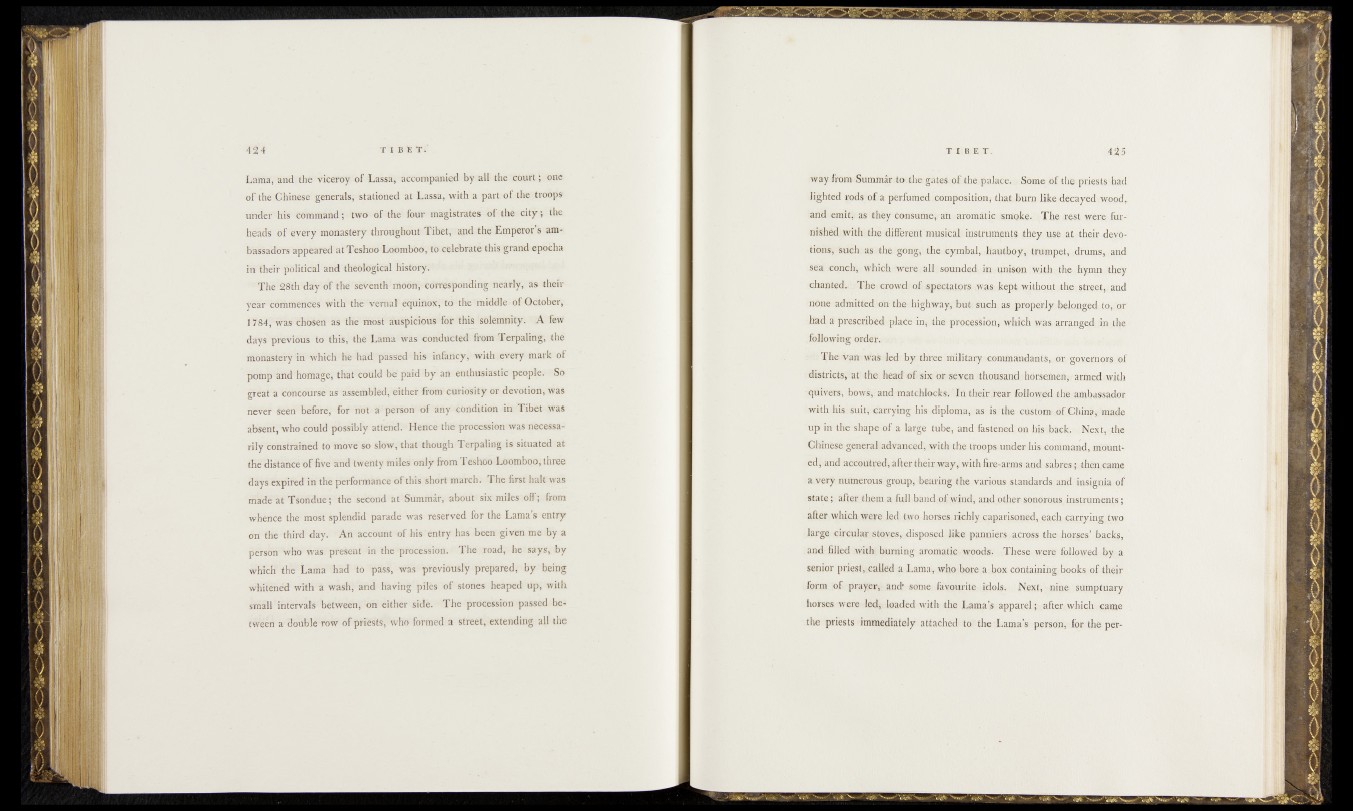
LaMa,; and-the vicerèjr'of Lassa-, accompanied by all the court; one
of the Chinese'generals, stationed at Lassa, with apartofthe; troops
under his command; two óf the four magistrates of the oityv the
heads of every monastery throughout Tibet, and the Emperor s am-
MbsaddrsPappearedat Teshoo Loomboo, to celebrate this grand epocha
M'fheir political and theological history.
The 28thday of the' j&%nêh;moêiri-corresponding nearly, as thefr
with !the!verhar equinox, to the^middletof ©ctober,
I‘}*84, waschosen as the most auspicious for this solemnity. A few
days previous to this, the Larta was conducted from Terpaling; the
monastery !SWhièh*hè had -passed- his infancy, with every mark of
pomp and homage, that could be paid by an enthusiastic people. S&
great a concourse as assembled, either from' curiosity or devotion, was
never seen before, for not a person óf any condition in Tibet was
absent, who could possibly attend. Hence the procession;was necessarily
constrained to move so slow, that though Terpaling is situated 'at
the distance of five and twenty miles' only from Teshoo Loomboo, three
days expired in the performance of this short march. The first halt was
made at Tsondue; the second at Summar, about six miles off; from
whence the most splendid parade was reserved for the Lama’s entry
on die third day. An account of his entry has been given me by a
person who was' present in the procession. The road, he says, by
which the Lama had to pass, was previously prepared, by being
whitened with a wash, and having-piles of stones heaped up, with
small ’ intervals between, on either side. The procession passed between
a double row of priests, who- Formed a street, extending all the
way from-<Sumta^rto;4hfisigatos4pfothe3,palaeen> :S<&me> .of -fchfe? priests h&d
lighted rods of,a phrfumed.composit-Lon, thaLburn like decayed iWood,
and emith as iihhy Consume, ah, a-roraStjie smoke. The rest were, fur-
niShid;wi'thi theili®rssBTf'
tions, such as,the gong;iihe,cymJaal, (hathhoy,, tpumpet, .drums,',.and
sea; conch, which <rwere, alfo sohuded in..?jnis@n; wifh }sthe jj hymn tfi^y
chanted- The crowd-, oTispectators,<wasi kept-i'syithotitwthe.jStreet,,and
^Aae admitted-on the* highway,- but, such vas11pBQp^lyi%^,^ggdivto)('ar'
hid a prescribed place in?, the procession},which wasj^Kmg^hfijn^be
.following a
MB The Van-waS'led- by three ritilUary commandants,odwgn^jjnqrjMof
distrtetsj'fot.'the. head of’six? or seven ;thQUSaHdshQrsejhehy; aimedwith
’^uivesfs, bows, and matchlocks; ‘ In their;rear followed the-a^ih^stddr
with;hisssuit, carrying his-diploma, as-is the,enstonafcdf Cfeina^'made
up in the shapeof a large tube, and fastened^ hisback.:.Nexty.the
Chinese general advanced, with the-traops,under his command, m in ted,
and accoutred, after their way, with fire-arms and safeties.- Aten p.atn<»
asver^;nu3merous group, bearing the various standards apd'insignia i©£
state; afterthem a full fraud ;p4 wind, and other.sonorous instruments;
after which Were fod two horses richly capjarjsongd, eapljfif^WiPS) ^ 0
.Ikrge circnl^-sto'v^a^^isposiedfiike panniers.across thevfrprges,’ fracks,
and- filled with burning aromatic woods. ,These were followed by ,a
senior priestycalfod a Lama, who bore a. box containing* books of their
form of prayer,- and some- favourite idols. Next, ^tip.e- Jsumptuai'y
horses were led, loaded with the Lama’s apparel; .after whfoh, came
the priests immediately attached-to> the Lama’s person, for the per